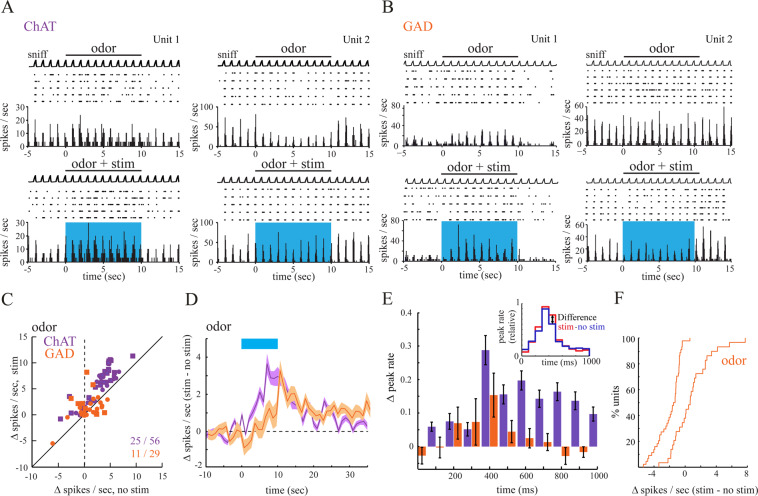Figure 3.
Optogenetic activation of cholinergic and GABAergic OB inputs modulates odor-evoked responses. (A) Odorant-evoked MTC spiking is enhanced by optical OB stimulation in ChAT-Cre mice in both odorant-activated (Unit1) and odorant-inhibited (Unit2) cells. (B) Odorant-evoked MTC spiking is increased (left) or decreased (right) by optical OB stimulation in GAD-Cre mice. (C) Plot of odorant-evoked changes in MTC spiking (∆ spikes/sniff) in the absence of (no stim) and during (stim) optogenetic stimulation of cholinergic (n = 56 units, purple) or GABAerig (n = 29, orange) afferents to the OB. (D) Time course of effects of optical stimulation on odorant-evoked spike rate, averaged across all units. The blue bar shows time of optical stimulation and simultaneous odorant presentation. Plotted is the mean change in odorant-evoked spike rate between trials with and without light stimulation, measured after each inhalation (at 1 Hz); the shaded area indicates variance (SEM) around mean. (E) Optical stimulation induced firing changes during the sniff cycle. Cholinergic modulation increased the firing rate across the sniff cycle. GABAergic modulation increased firing in peak and adjacent time bins while inhibiting firing outside the “preferred sniff phase”. Firing changes were calculated form sniff-triggered spike histograms as depicted in the inset. (F) Cumulative probability plots comparing changes in MTC firing rates caused by optical stimulation in the no sniff and odor condition. Plots reflect datasets plotted in Figs. 2B and 3C, respectively. Unlike the uniform suppression of spontaneous spiking observed in GAD-Cre mice, optical stimulation in the odor condition predominantly causes MTC excitation.

